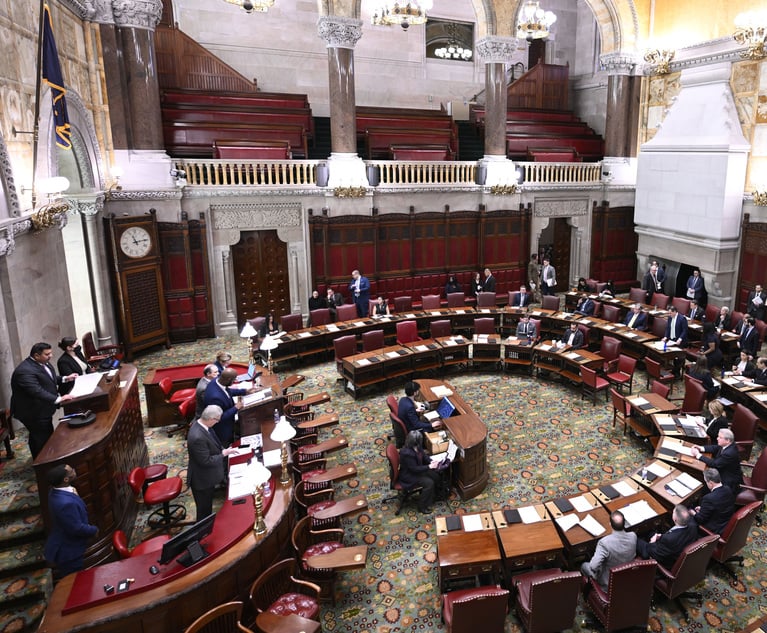New York State Needs More Judges, Outgoing Senate Judiciary Chairman Says
That would require more funding in the state budget, where spending for the judiciary has been capped in recent years, said State Sen. John Bonacic, R-Orange, the outgoing chairman of the Senate Judiciary Committee.
July 16, 2018 at 03:59 PM
6 minute read
 Bonacic decided not to seek re-election this year after spending 20 years in the State Senate. He represents Sullivan County and parts of his home county of Orange, as well as portions of Ulster and Delaware counties. He still has more than five months left as chairman of the judiciary committee, but it's unlikely it will meet. The Legislature isn't scheduled to return until January, at which point a new chairman of the committee will be selected by the majority leader of the Senate. Bonacic said he does not have anyone in mind to replace him for the position, but he has an idea of what kind of person he or she should be. “We have some very intelligent attorneys and I don't want to be ordaining the next chairman,” Bonacic said in an interview with the New York Law Journal. “I do think it's important that whoever that chairman is, whether Democrat or Republican, that they keep a balance of ideology. I think that's critically important, that they don't go off the deep end and become an activist of an extreme judicial agenda.” Bonacic said he was chosen to chair the judiciary committee in 2011 by former Senate Majority Leader Dean Skelos for his experience as a litigator. He's retired from private practice now, but previously spent more than three decades in law. “I have done extensive legal work in a variety of areas,” Bonacic said. “I was a litigator. I was an assistant district attorney. I was a bank attorney. I was a top matrimonial attorney in the 1980s. You name it, I've done it, basically, in law.” Bonacic has been in public service for more than four decades. He served as an assistant district attorney in Orange County and later was elected to the county legislature, where he remained for 16 years. He left that position for a seat in the State Assembly in 1990 before his election to the State Senate in 1998. His eight years as head of the judiciary committee have been peppered with accomplishments and challenges alike. Perhaps most notable is the committee's opportunity to approve each judge that currently sits on the Court of Appeals. The committee's work is not usually the focus of any end-of-year deals between the governor and the Legislature. The committee approved eight new judges to the state Court of Claims in June and other members of the Senate didn't bat an eye. For the state judiciary, however, the committee is critical. Bonacic was a point of contact for Court of Appeals Chief Judge Janet DiFiore during state budget negotiations, he said, and they worked together frequently to improve the state's court system. “I loved working with Judge DiFiore. I loved her Excellence Initiative,” Bonacic said. “She's a tremendous administrator. She has good judgment and temperament. She was an excellent appointment.” DiFiore's Excellence Initiative began as a way to reduce case backlog in the state's courts in 2016. Since then, the backlog has gone down, according to a report released this year by the state court system. The report attributes the success to new technology, continued education, and better efficiency in courts. The progress has been good, Bonacic said, but the Legislature could also play a role in reducing the backlog. Lawmakers approved 25 new family court justices in 2014, for example, but the barrier to adding more in courts statewide has been spending, Bonacic said. “I got requests all the time throughout the state—we need another judge up in Albany, we need another judge up in Wayne County—always asking for more judges to be authorized by the Legislature,” Bonacic said. “But these become budgetary issues and keep in mind that the governor wanted to keep his 2 percent cap on spending in all areas. “I'm not saying it's bad to try to control state spending but a 2 percent cap in every area has affected the judiciary,” Bonacic said. It's also created a situation Bonacic hopes a future judiciary chairman can resolve. Judges on the state Court of Claims are nominated by the governor and approved by the Senate, as the chamber did in June. Those judges are chosen to preside over litigation against the state and certain state-related entities. The Court of Claims judges are also often assigned to preside over trial courts, Bonacic said. “The chief administrator can assign judges to work other courts and lots of times they take them because there's such a demand on the system,” Bonacic said. “We've become much more litigious as a society so the caseloads on judges have increased exponentially.” The problem with that, Bonacic said, is that the Court of Claims judges are then doing the work of an elected judge without being chosen by voters. Some may not be the quality that people would elect, Bonacic said. His solution? “You authorize more Supreme Court judges to run,” Bonacic said. “I would rather they be elected by the people than the backdoor way of supplying Supreme Court judge work but as a Court of Claims appointee.” Gov. Andrew Cuomo proposed earlier this year to have the state comptroller certify that judges work eight hours a day to reduce backlog. The proposal was not favored by some judges , who likened it to punching a time card. The idea did not make it into this year's state budget, partly because of Bonacic's opposition as judiciary chairman. “I rejected it because I thought it was disrespectful and whether you have an isolated case of one or two people, the whole system is under siege of litigation and they have to work by the nature of what's happening in courts,” Bonacic said, “and they're a separate branch of government so they deserve respect and budget allocations to do their job.” Bonacic also warned his successor against other efforts by Cuomo, or a future governor, to try to gain more power over the judiciary, whether through policy or funding. That's a slippery slope to a state government with fewer checks and balances, Bonacic said. “They should make sure that there's separation of the branches of government,” Bonacic said. “Don't let the governor take over the judiciary or the Legislature for that matter. A powerful governor could try to do that.”
Bonacic decided not to seek re-election this year after spending 20 years in the State Senate. He represents Sullivan County and parts of his home county of Orange, as well as portions of Ulster and Delaware counties. He still has more than five months left as chairman of the judiciary committee, but it's unlikely it will meet. The Legislature isn't scheduled to return until January, at which point a new chairman of the committee will be selected by the majority leader of the Senate. Bonacic said he does not have anyone in mind to replace him for the position, but he has an idea of what kind of person he or she should be. “We have some very intelligent attorneys and I don't want to be ordaining the next chairman,” Bonacic said in an interview with the New York Law Journal. “I do think it's important that whoever that chairman is, whether Democrat or Republican, that they keep a balance of ideology. I think that's critically important, that they don't go off the deep end and become an activist of an extreme judicial agenda.” Bonacic said he was chosen to chair the judiciary committee in 2011 by former Senate Majority Leader Dean Skelos for his experience as a litigator. He's retired from private practice now, but previously spent more than three decades in law. “I have done extensive legal work in a variety of areas,” Bonacic said. “I was a litigator. I was an assistant district attorney. I was a bank attorney. I was a top matrimonial attorney in the 1980s. You name it, I've done it, basically, in law.” Bonacic has been in public service for more than four decades. He served as an assistant district attorney in Orange County and later was elected to the county legislature, where he remained for 16 years. He left that position for a seat in the State Assembly in 1990 before his election to the State Senate in 1998. His eight years as head of the judiciary committee have been peppered with accomplishments and challenges alike. Perhaps most notable is the committee's opportunity to approve each judge that currently sits on the Court of Appeals. The committee's work is not usually the focus of any end-of-year deals between the governor and the Legislature. The committee approved eight new judges to the state Court of Claims in June and other members of the Senate didn't bat an eye. For the state judiciary, however, the committee is critical. Bonacic was a point of contact for Court of Appeals Chief Judge Janet DiFiore during state budget negotiations, he said, and they worked together frequently to improve the state's court system. “I loved working with Judge DiFiore. I loved her Excellence Initiative,” Bonacic said. “She's a tremendous administrator. She has good judgment and temperament. She was an excellent appointment.” DiFiore's Excellence Initiative began as a way to reduce case backlog in the state's courts in 2016. Since then, the backlog has gone down, according to a report released this year by the state court system. The report attributes the success to new technology, continued education, and better efficiency in courts. The progress has been good, Bonacic said, but the Legislature could also play a role in reducing the backlog. Lawmakers approved 25 new family court justices in 2014, for example, but the barrier to adding more in courts statewide has been spending, Bonacic said. “I got requests all the time throughout the state—we need another judge up in Albany, we need another judge up in Wayne County—always asking for more judges to be authorized by the Legislature,” Bonacic said. “But these become budgetary issues and keep in mind that the governor wanted to keep his 2 percent cap on spending in all areas. “I'm not saying it's bad to try to control state spending but a 2 percent cap in every area has affected the judiciary,” Bonacic said. It's also created a situation Bonacic hopes a future judiciary chairman can resolve. Judges on the state Court of Claims are nominated by the governor and approved by the Senate, as the chamber did in June. Those judges are chosen to preside over litigation against the state and certain state-related entities. The Court of Claims judges are also often assigned to preside over trial courts, Bonacic said. “The chief administrator can assign judges to work other courts and lots of times they take them because there's such a demand on the system,” Bonacic said. “We've become much more litigious as a society so the caseloads on judges have increased exponentially.” The problem with that, Bonacic said, is that the Court of Claims judges are then doing the work of an elected judge without being chosen by voters. Some may not be the quality that people would elect, Bonacic said. His solution? “You authorize more Supreme Court judges to run,” Bonacic said. “I would rather they be elected by the people than the backdoor way of supplying Supreme Court judge work but as a Court of Claims appointee.” Gov. Andrew Cuomo proposed earlier this year to have the state comptroller certify that judges work eight hours a day to reduce backlog. The proposal was not favored by some judges , who likened it to punching a time card. The idea did not make it into this year's state budget, partly because of Bonacic's opposition as judiciary chairman. “I rejected it because I thought it was disrespectful and whether you have an isolated case of one or two people, the whole system is under siege of litigation and they have to work by the nature of what's happening in courts,” Bonacic said, “and they're a separate branch of government so they deserve respect and budget allocations to do their job.” Bonacic also warned his successor against other efforts by Cuomo, or a future governor, to try to gain more power over the judiciary, whether through policy or funding. That's a slippery slope to a state government with fewer checks and balances, Bonacic said. “They should make sure that there's separation of the branches of government,” Bonacic said. “Don't let the governor take over the judiciary or the Legislature for that matter. A powerful governor could try to do that.”This content has been archived. It is available through our partners, LexisNexis® and Bloomberg Law.
To view this content, please continue to their sites.
Not a Lexis Subscriber?
Subscribe Now
Not a Bloomberg Law Subscriber?
Subscribe Now
NOT FOR REPRINT
© 2025 ALM Global, LLC, All Rights Reserved. Request academic re-use from www.copyright.com. All other uses, submit a request to [email protected]. For more information visit Asset & Logo Licensing.
You Might Like
View All
Relaxing Penalties on Discovery Noncompliance Allows Criminal Cases to Get Decided on Merit
5 minute read
Bipartisan Lawmakers to Hochul Urge Greater Student Loan Forgiveness for Public-Interest Lawyers

'Playing the Clock'?: Hochul Says NY's Discovery Loophole Is to Blame for Wide Dismissal of Criminal Cases

So Who Won? Congestion Pricing Ruling Leaves Both Sides Claiming Victory, Attorneys Seeking Clarification
4 minute readTrending Stories
- 1US DOJ Threatens to Prosecute Local Officials Who Don't Aid Immigration Enforcement
- 2Kirkland Is Entering a New Market. Will Its Rates Get a Warm Welcome?
- 3African Law Firm Investigated Over ‘AI-Generated’ Case References
- 4Gen AI and Associate Legal Writing: Davis Wright Tremaine's New Training Model
- 5Departing Attorneys Sue Their Former Law Firm
Who Got The Work
J. Brugh Lower of Gibbons has entered an appearance for industrial equipment supplier Devco Corporation in a pending trademark infringement lawsuit. The suit, accusing the defendant of selling knock-off Graco products, was filed Dec. 18 in New Jersey District Court by Rivkin Radler on behalf of Graco Inc. and Graco Minnesota. The case, assigned to U.S. District Judge Zahid N. Quraishi, is 3:24-cv-11294, Graco Inc. et al v. Devco Corporation.
Who Got The Work
Rebecca Maller-Stein and Kent A. Yalowitz of Arnold & Porter Kaye Scholer have entered their appearances for Hanaco Venture Capital and its executives, Lior Prosor and David Frankel, in a pending securities lawsuit. The action, filed on Dec. 24 in New York Southern District Court by Zell, Aron & Co. on behalf of Goldeneye Advisors, accuses the defendants of negligently and fraudulently managing the plaintiff's $1 million investment. The case, assigned to U.S. District Judge Vernon S. Broderick, is 1:24-cv-09918, Goldeneye Advisors, LLC v. Hanaco Venture Capital, Ltd. et al.
Who Got The Work
Attorneys from A&O Shearman has stepped in as defense counsel for Toronto-Dominion Bank and other defendants in a pending securities class action. The suit, filed Dec. 11 in New York Southern District Court by Bleichmar Fonti & Auld, accuses the defendants of concealing the bank's 'pervasive' deficiencies in regards to its compliance with the Bank Secrecy Act and the quality of its anti-money laundering controls. The case, assigned to U.S. District Judge Arun Subramanian, is 1:24-cv-09445, Gonzalez v. The Toronto-Dominion Bank et al.
Who Got The Work
Crown Castle International, a Pennsylvania company providing shared communications infrastructure, has turned to Luke D. Wolf of Gordon Rees Scully Mansukhani to fend off a pending breach-of-contract lawsuit. The court action, filed Nov. 25 in Michigan Eastern District Court by Hooper Hathaway PC on behalf of The Town Residences LLC, accuses Crown Castle of failing to transfer approximately $30,000 in utility payments from T-Mobile in breach of a roof-top lease and assignment agreement. The case, assigned to U.S. District Judge Susan K. Declercq, is 2:24-cv-13131, The Town Residences LLC v. T-Mobile US, Inc. et al.
Who Got The Work
Wilfred P. Coronato and Daniel M. Schwartz of McCarter & English have stepped in as defense counsel to Electrolux Home Products Inc. in a pending product liability lawsuit. The court action, filed Nov. 26 in New York Eastern District Court by Poulos Lopiccolo PC and Nagel Rice LLP on behalf of David Stern, alleges that the defendant's refrigerators’ drawers and shelving repeatedly break and fall apart within months after purchase. The case, assigned to U.S. District Judge Joan M. Azrack, is 2:24-cv-08204, Stern v. Electrolux Home Products, Inc.
Featured Firms
Law Offices of Gary Martin Hays & Associates, P.C.
(470) 294-1674
Law Offices of Mark E. Salomone
(857) 444-6468
Smith & Hassler
(713) 739-1250






